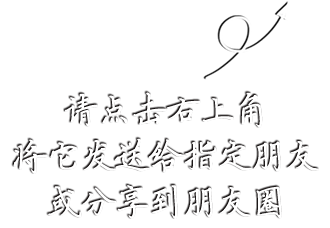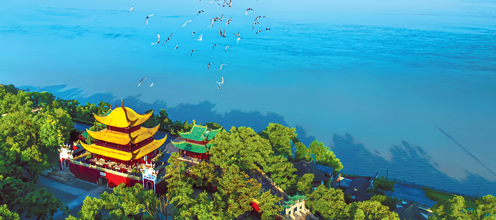
Yueyang Tower on the shore of Dongting Lake is a masterpiece of ancient architecture with nearly 1,800 years of history in Yueyang city.

Pandas eat bamboo at the Yueyang China Panda Garden.
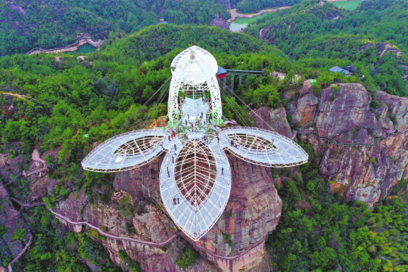
A large glass viewing platform in the Shiniuzhai scenic area in Yueyang.
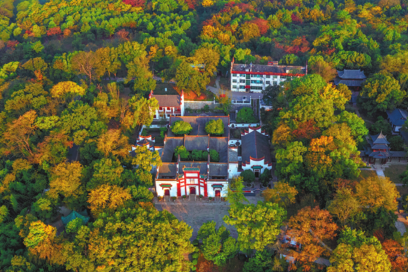
The Quzi Temple in Yueyang is a piece of ancient architecture in memory of Qu Yuan, a poet in the Warring States Period (475-221 BC).

The Jiangtun Bay scenic area in Yueyang.

The Changle Taige performances in Yueyang is a national-level intangible cultural heritage item.
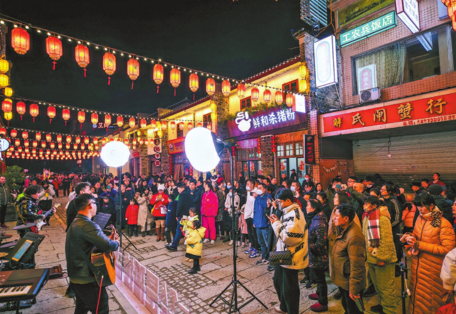
A historical and cultural block in Yueyang.

An international dragon boat race is held on the Miluo River in Yueyang.
Yueyang, a city steeped in history and nestled along the Yangtze River, is hosting the fourth Hunan Tourism Development Conference from Saturday to Monday.
More than a regional gathering, the event serves as a cultural invitation to the world, showcasing Yueyang's profound heritage and unique charm through a series of activities rooted in the Yangtze River civilization.
The conference features three core activities designed to highlight Hunan's tourism ambitions, including a Hunan inbound tourism promotion conference, aiming to attract global visitors to the province's scenic and cultural treasures.
Complementing these are five supporting events. These include the 2025 World Tourism Alliance Dongting Dialogue, a platform for international tourism stakeholders to exchange ideas, and the Yueyang 2025 International Guqin Art Season, celebrating the city's deep connection with this ancient Chinese musical instrument.
The conference has revealed its tourism logo, drawing inspiration from the silhouette of Yueyang Tower to highlight unique regional characteristics. Additionally, mascots Jiang Xiaotun and Yue Xiaolou are inspired by the protected finless porpoise and the iconic Yueyang Tower, respectively.
Jiang Xiaotun, embellished with intricate wave patterns on its feet, symbolizes its bond with Dongting Lake, adding energy and vitality. Meanwhile, Yue Xiaolou sports a miniature Yueyang Tower on its head and treads upon auspicious clouds. This representation not only captures the historical allure of the tower but signifies the prosperity and auspiciousness of tourism in Yueyang.
"Hosting the provincial tourism conference is a golden opportunity for Yueyang," said Liu Qifeng, director of the city's publicity department. "We will leverage the city's rich cultural and tourism resources, strengthen the integration of culture and tourism, and strive to build a world-class tourism destination," he said.
Cradle of civilization
As a national historical and cultural city, Yueyang in Central China's Hunan province is one of the birthplaces of Chinese civilization and a cradle of Huxiang culture.
Archaeological discoveries reveal a staggering timeline. A Paleolithic site — the earliest period of the Stone Age — in the area testifies to human habitation as far back as 200,000 years ago. The Neolithic era — the latest period of the Stone Age — left an even more vivid imprint, with more than 130 discovered sites.
These sites span almost all cultural phases of the Neolithic period, documenting the arduous journey of Yueyang's ancestors as they transitioned from hunting and gathering to agriculture, animal husbandry, pottery-making, architecture, and textile production.
Yueyang's historical significance extends to its role as a treasure trove of cultural relics. The city boasts 17 national key cultural relic protection units, accounting for about 10 percent of Hunan's total, as well as 44 provincial-level units, and more than 240 municipal and county-level units.
To transform these resources into cultural landmarks, Liu emphasized plans to enhance the research and promotion of local cultural characteristics, focusing on creating brands related to the Yueyang Tower, Qu Yuan, and Guqin. Their stories and connotations will be integrated into scenic spots, tourism routes, exhibitions and educational experiences, creating more products that blend leisure tourism with culture.
Beyond preserving history, Yueyang aims to modernize its tourism infrastructure by conducting regular surveys of cultural and tourism resources, strengthening resource integration, and improving service quality.
Yueyang was designated as an opening-up tourism city in 1979 and then listed as one of the first opening-up cities along the Yangtze River in 1992.
The city benefits from exceptional geographic advantages, with the Beijing-Guangzhou High-Speed Railway, Beijing-Hong Kong-Macao Expressway, and National Highway 107 traversing it.
"We will promote tourism plus sports and performances through events like the Miluo River Dragon Boat Festival and the Dongting Fishing Fire Season; boost tourism plus agriculture and health to develop vacation resorts, homestays, and gourmet industries; and develop tourism plus technology and education to create immersive, experiential, and interactive new formats, driving new quality productive forces in cultural tourism," Liu said.
Iconic tower
At the heart of city's tourism landscape stands the Yueyang Tower, a masterpiece of ancient architecture with nearly 1,800 years of history. Rising from its origins as a military watchtower to a scenic pavilion, it ranks among the three great towers of Jiangnan (south of the lower reaches of the Yangtze River), alongside the Yellow Crane Tower in Wuhan and the Pavilion of Prince Teng in Nanchang. Among the three, Yueyang Tower is the only one to retain its original Qing Dynasty (1644-1911) structure.
The tower's fame owes much to Yueyanglou Ji (The Memorial to Yueyang Tower), a 360-character literary gem written by Fan Zhongyan (989-1052), a Song Dynasty (960-1279) poet and politician. The essay's iconic phrase "to worry before all others have worried, to rejoice after all others have rejoiced" has become a symbol of Chinese civic virtue, embodying the nation's spirit and resonated through the ages.
As a national key cultural protection unit and a core component of the Dongting Lake national scenic area, the tower made the list of top 10 cultural heritages of Hunan in 2005. It was designated a national 5A-level tourist attraction in 2011.
Bai Zaixing, head of the city's Yueyanglou district, announced plans to create a Yueyang Tower historical and cultural protection and utilization demonstration zone.
"Centering on the Yueyang Tower scenic area, we will integrate Dongting Lake, Junshan Island, and the tower itself, connecting attractions like the Dongting South Road Historical and Cultural Zone, Yueyang Confucian Temple, Lu Su's Tomb, and Yueyang Port Industrial Ruins Park. We will also develop water entertainment, night performances, and lantern festivals to enrich tourism experiences," he said.
The district will also enhance urban aesthetics through landscape renovations and night lighting, creating internet-famous spots and youth areas while maintaining a clean and livable environment.
Support will be extended to hotels, catering and entertainment industries, with incentives for residents and businesses to engage in tourism-related ventures such as trendy entertainment, homestays, intangible cultural heritage projects, and cultural and creative products.
Junshan Island
Opposite Yueyang Tower lies Junshan Island in Dongting Lake. It is a small cluster of 72 peaks and a national 5A-level tourist attraction.
Revered for its "wonders, compactness, and elegance", the island has inspired poets and scholars for centuries. Tang Dynasty (618-907) giants like Li Bai and Du Fu, along with Song and Qing dynasties' literati such as Huang Tingjian, Xin Qiji and Zhang Zhidong, left behind countless verses praising its beauty.
Today, Junshan Island is a haven of natural beauty, with ancient forests and more than 20 species of rare bamboo. Its terraced tea plantations, like green ribbons across the hills, produce Junshan Yinzhen, one of China's top 10 teas, adding another dimension to the island's cultural allure.
As Yueyang welcomes visitors from around the world, the Hunan Tourism Development Conference promises to be a milestone in showcasing China's cultural heritage while embracing modern tourism.
With its blend of ancient history, natural landscapes, and strategic vision, Yueyang is poised to solidify its position as a must-visit destination, inviting travelers to experience the timeless charm of the Yangtze River civilization and the vibrant spirit of Hunan, local officials said.
haonan@chinadaily.com.cn

